PXIe-148X Getting Started Example - Basic Tap Tutorial
This tutorial will teach you the steps needed to configure a tap acquisition using two PXIe-148X modules with a Leopard Imaging IMX490 camera and familiarize you with the basic functionality provided by the Tap Getting Started Example. A tap acquisition is defined as an acquisition with a CSI-2 sensor where data is forwarded from a serial input channel to a paired serial output channel while also logging acquired data and timestamps to disk. In addition, the Tap Getting Started Example bridges the I2C communication between the paired serial input and serial output channels.
Note: This document references the example included with the NI-FlexRIO 23Q1 driver. Examples included in newer releases of the driver should be applicable.
Table of contents
- Prerequisites
- Initial Hardware Setup
- Initial Software Setup
- Performing a Simple Continuous Tap Acquisition
- Performing a Finite Tap Acquisition with Data Logging
- Reviewing Previously Logged Data
- Related Documents
Prerequisites
Review and complete all setup from the appropriate getting started guide:
- PXIe-1486 Getting Started Guide
- PXIe-1487 Getting Started Guide
- PXIe-1488 Getting Started Guide
- PXIe-1489 Getting Started Guide
Basic knowledge of LabVIEW and LabVIEW FPGA concepts.
A camera supported by the getting started example configuration scripts (i.e. Leopard Imaging IMX490).
A supported PXIe-148X interface module that includes both serial input and serial output channels (tap module) and a second supported interface module that includes serial input channels (acq module) on a PXI system running Windows. The table below lists all supported tap and acq modules and supported cameras that have configuration scripts provided with the getting started example. For modules and cameras not listed in the table below, configuration scripts need to be provided separately.
| Interface Module | Camera |
|---|---|
| PXIe-1486 (8 In - 954 Deserializer) | LI-IMX490-FPDLINKIII |
| PXIe-1486 (4 In 4 Out - 953/954 SerDes) | LI-IMX490-FPDLINKIII |
| PXIe-1487 (8 In - 9296A Deserializer) | LI-IMX490-GMSL2 |
| PXIe-1487 (4 In 4 Out - 9295A/9296A SerDes) | LI-IMX490-GMSL2 |
Note: The tap and acq modules used in this tutorial must have matching model numbers (i.e. 1486).
Initial Hardware Setup
- First complete installation of hardware as described in the Getting Started Guide linked above.
- Connect the camera to serial input channel 0 (SI0) on the tap module with a FAKRA cable.
- Connect serial output channel (SO0) on the tap module to serial input channel (SI0) on the acq module with a FAKRA cable.
- Connect the SI0 pin to the SO0 pin on the AUX POWER connector on the front panel of the tap module.
Initial Software Setup
- First complete installation of software specified in the Getting Started Guide linked above.
- Use the NI Example Finder to create a default project for your specific tap module.
- Open LabVIEW and click Help -> Find Examples…
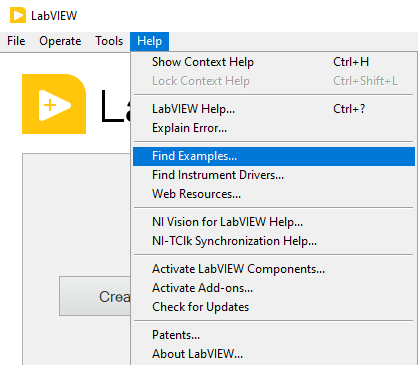
- In the NI Example Finder dialog, double-click Hardware Input and Output -> FlexRIO -> Integrated IO -> Getting Started -> Getting Started FlexRIO Integrated IO.vi
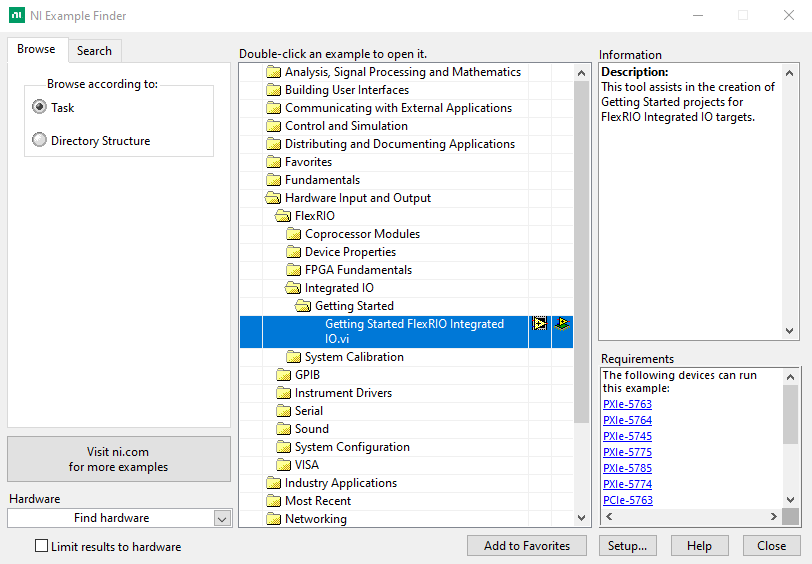
- In the FlexRIO with Integrated IO Project Creator dialog set the Project Name to PXIe-148X Tutorial and make the FlexRIO Integrated IO selection for the desired PXIe-148X interface module then click OK.
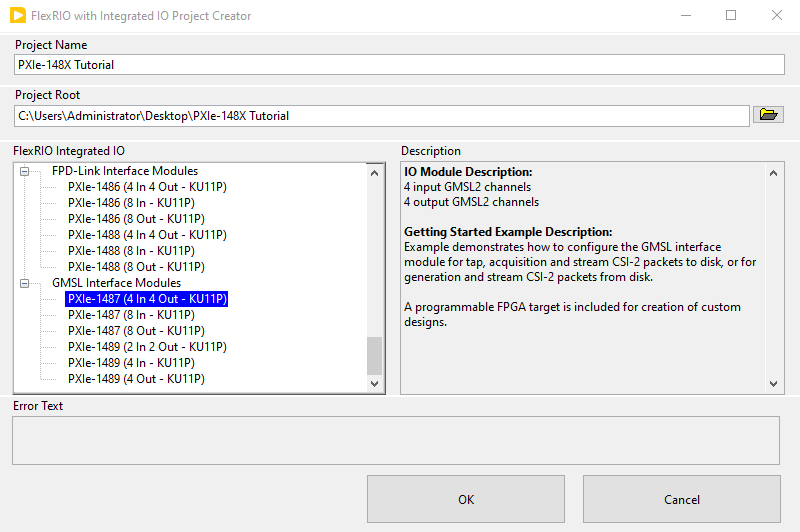
-
Double click the Tap Example VI in the LabVIEW project.
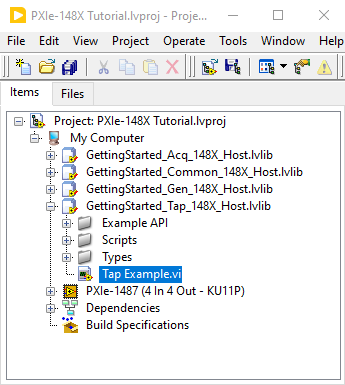
The opened front panel of the Getting Started Example is similar to the figure below.
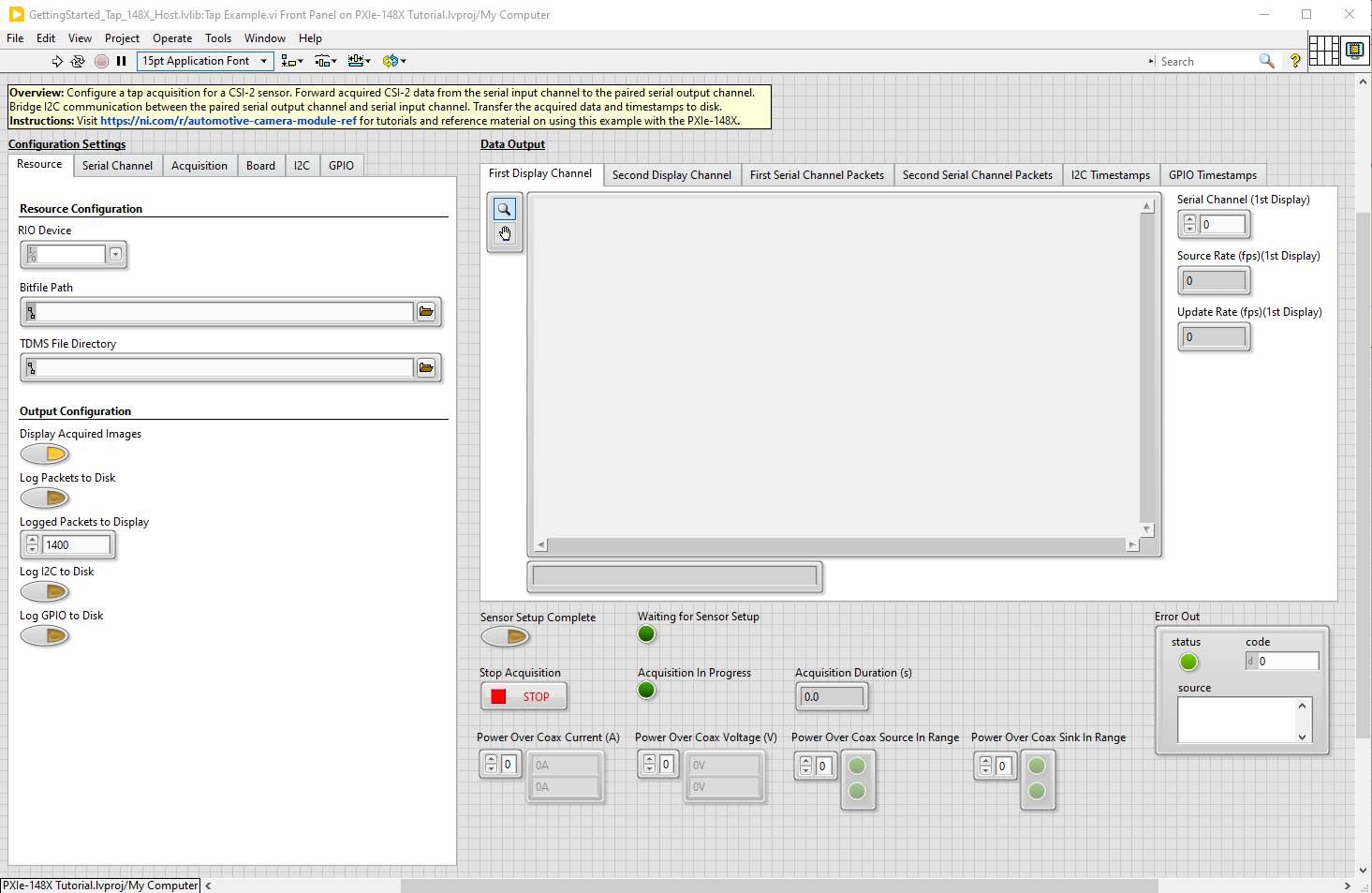
- Open an Acquisition Example VI (see Basic Acquisition Tutorials - Initial Software Setup).
Note: If the acq module is the same module type as the tap module, there is no need to create a new project. If the acq module is not the same module type as the tap module, a new project needs to be created for the acq module in order for the acq module FPGA bitfiles to be included in the project.
Performing a Simple Continuous Tap Acquisition
Note: For the purposes of this tutorial, all steps reference the Tap Example VI unless otherwise specified and all input control values not specified should be left as the default value.
- Select the Resource tab and make the following modifications.
- Select the RIO Device from the dropdown menu that corresponds to your tap module.
- Set the Bitfile Path to the bitfile that corresponds to your tap module. The default shipping bitfile is in the ‘FPGA Bitfiles’ subfolder located in the project folder (created at the Project Root location specified in Project Creator):
Interface Module Bitfile PXIe-1486 (4 In 4 Out) FPGA Bitfiles\PXIe_1486_4_In_4_Out_Acq_Tap.lvbitx PXIe-1487 (4 In 4 Out) FPGA Bitfiles\PXIe_1487_4_In_4_Out_Acq_Tap.lvbitx PXIe-1488 (4 In 4 Out) FPGA Bitfiles\PXIe_1488_4_In_4_Out_Acq_Tap.lvbitx PXIe-1489 (2 In 2 Out) FPGA Bitfiles\PXIe_1489_2_In_2_Out_Acq_Tap.lvbitx The values on the Resource tab of Configuration Settings are now similar to the figure below.
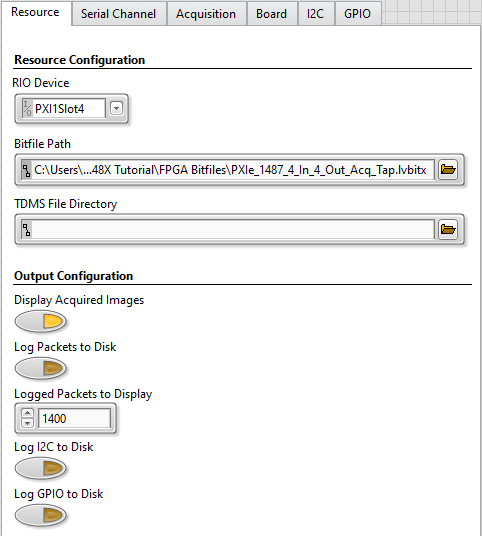
- Select the Serial Channel tab and make the following modifications.
-
Select the Deserializer (Input) Configuration Script and Serializer (Output) Configuration Script that correspond to your interface module. The tap scripts are used to configure the deserializer and the serializer on the interface module to establish the I2C communication bridge between input and output channel pairs. See the PXIe-148X Configuration Scripts User Guide for more details. The configuration scripts required for this tutorial are in the project folder under the subfolder ‘Host\Scripts’:
Interface Module Deserializer (Input) Configuration Script PXIe-1486 (4 In 4 Out - 953/954 SerDes) Host\Scripts\DS90UB954\Tap\Des_Tap.py PXIe-1487 (4 In 4 Out - 9295A/9296A SerDes) Host\Scripts\MAX9296A\Tap\RAW12_ID01_Des_Tap.cpp PXIe-1487 (4 In 4 Out - 96717/96716A SerDes) Host\Scripts\MAX96716A\Tap\RAW12_ID12_Des_Tap.cpp PXIe-1488 (4 In 4 Out - 971/9702 SerDes) Host\Scripts\DS90UB9702\Tap\Des_Tap.py PXIe-1489 (2 In 2 Out - 96793/96792A SerDes) Host\Scripts\MAX96792A\Tap\RAW12_ID12_Des_Tap.cpp Interface Module Serializer (Output) Configuration Script PXIe-1486 (4 In 4 Out - 953/954 SerDes) Host\Scripts\DS90UB953\Tap\Ser_Tap.py PXIe-1487 (4 In 4 Out - 9295A/9296A SerDes) Host\Scripts\MAX9295A\Tap\RAW12_ID1_Ser_Tap.cpp PXIe-1487 (4 In 4 Out - 96717/96716A SerDes) Host\Scripts\MAX96717\Tap\RAW12_ID2_Ser_Tap.cpp PXIe-1488 (4 In 4 Out - 971/9702 SerDes) Host\Scripts\DS90UB971\Tap\Ser_Tap.py PXIe-1489 (2 In 2 Out - 96793/96792A SerDes) Host\Scripts\MAX96793\Tap\RAW12_ID2_Ser_Tap.cpp
The values on the Serial Channel tab of Configuration Settings are now similar to the figure below.
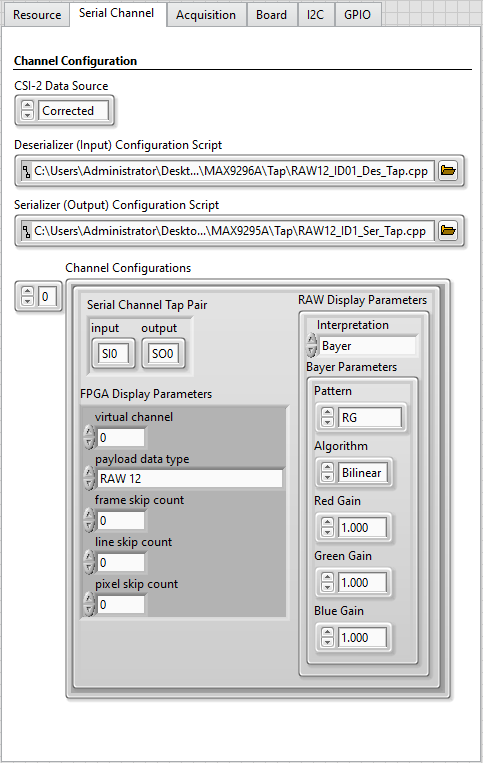
-
- Select the Board tab and make the following modifications.
- In the Power Over Coax Source drop down menu, select Auxiliary to power the attached camera from the AUX POWER connector.
- In the Power Over Coax Sink drop down menu, select Auxiliary to route received power over coax to the AUX POWER connector.
The values on the Board tab of Configuration Settings are now similar to the figure below.
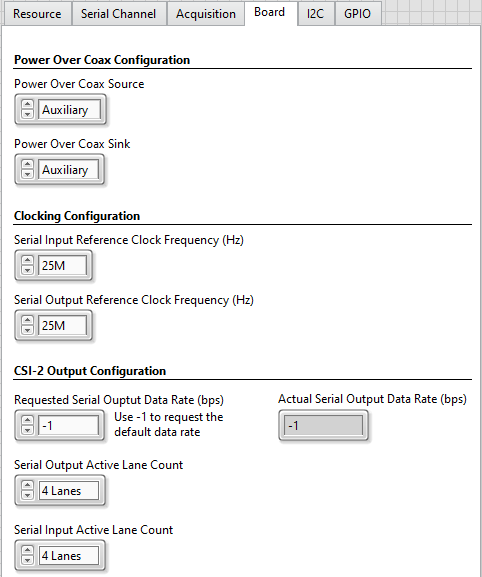
-
Run the VI to setup the tap configuration.
The Tap example loads the bitfile and applies the configuration settings, including execution of the deserializer and serializer configuration scripts. The Waiting for Sensor Setup indicator illuminates to indicate the configuration scripts have completed and the I2C communication bridge is established between serial input and serial output channel pairs.
-
Click the Sensor Setup Complete control button to start a continuous tap acquisition.
The Acquisition In Progress indicator illuminates to indicate that the tap acquisition is running, but no data is received at this point since the camera configuration is performed from the Acquisition Example VI.
-
On the Acquisition Example VI, run the Performing a Simple Continuous Acquisition tutorial using the acq module, but do not run the final step that stops the acquisition.
-
Update the Red Gain, Green Gain, and Blue Gain display parameters on the Serial Channel tab -> Channel Configurations control to match any changes that were made on the Acquisition Example VI.
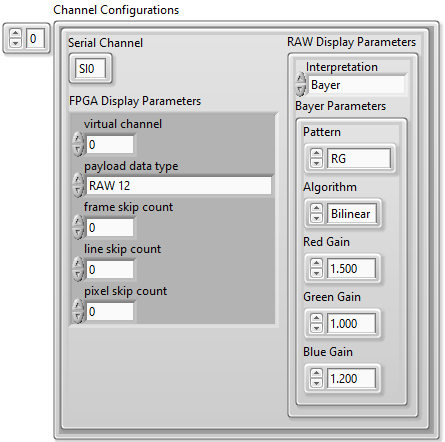
Note: Changes made to the RAW Display Parameters will take effect while the VI is running.
-
While the Tap Example and Acquisition Example VIs are running, select the First Display Channel tab on the Tap Example and on the Acquisition Example and verify that images from the camera are displayed on these tabs. The images should look identical.
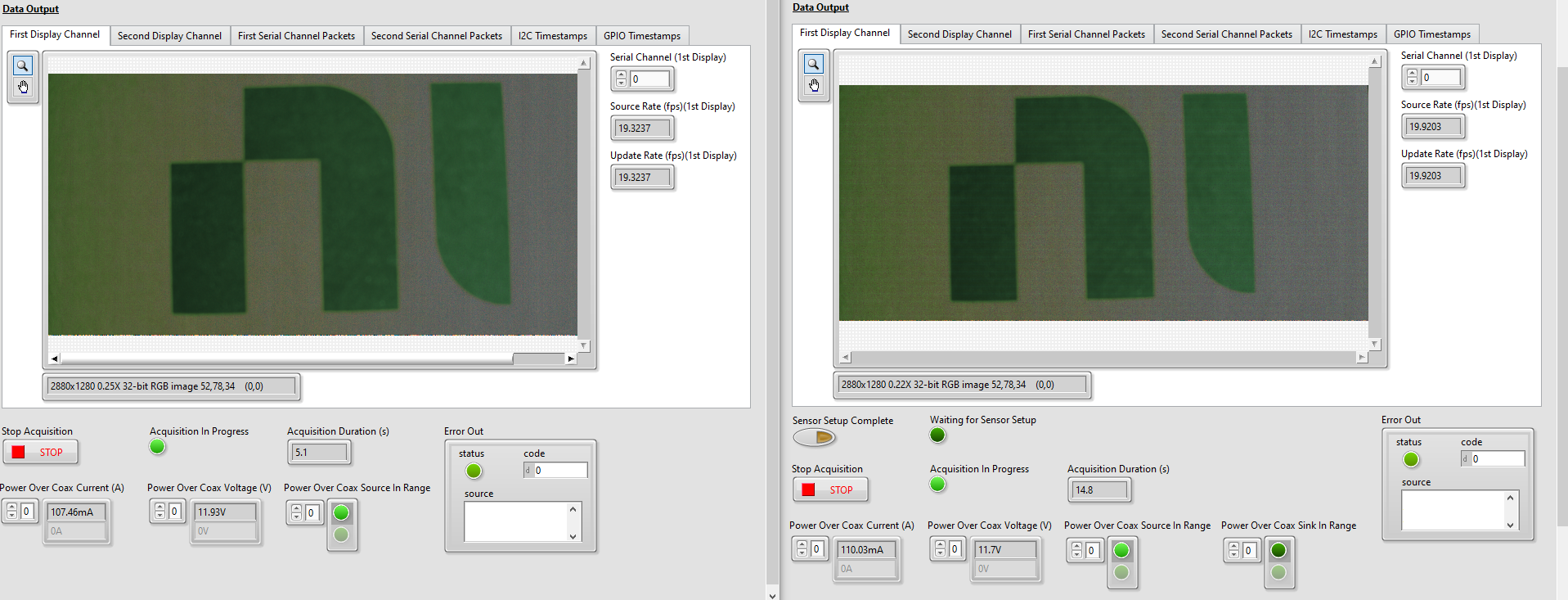
- Click the Stop Acquisition button on both Example VIs to stop the tap acquisition and stop the VIs.
Performing a Finite Tap Acquisition with Data Logging
Note: The Finite Tap Acquisition with Data Logging tutorial assumes that all input parameters are still configured as specified in the Simple Continuous Tap Acquisition tutorial for both the Tap and Acquisition Example VIs. All steps reference the Tap Example VI unless otherwise specified
- Select the Resource tab and make the following modifications.
- Enable Log Packets to Disk.
- Enable Log I2C to Disk.
- Enable Log GPIO to Disk.
Note: During the first run of the VI in the Simple Continuous Tap Acquisition tutorial, the TDMS File Directory control was automatically populated with a value pointing to a subfolder ("TDMS Files"). This subfolder was automatically created within the project folder to store any generated TDMS files.
The values on the Resource tab of Configuration Settings are now similar to the figure below.
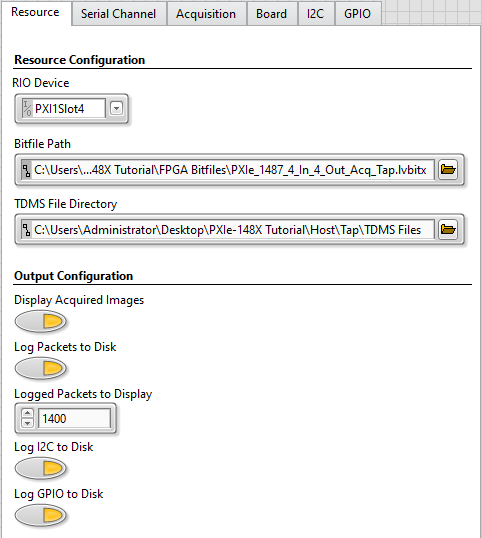
-
Select the Acquisition tab and disable Continuous Acquisition.
The values on the Acquisition tab of Configuration Settings are now similar to the figure below.
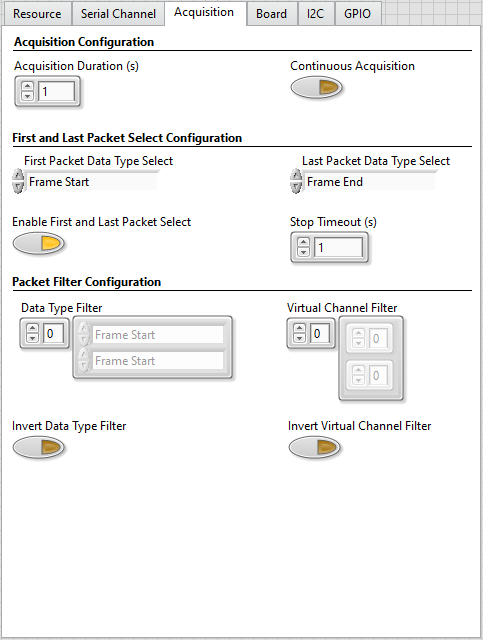
-
Select the I2C tab and add User24 to the timestamp filter array to enable I2C timestamp logging on the SI0 channel.
The values on the I2C tab of Configuration Settings are now similar to the figure below.
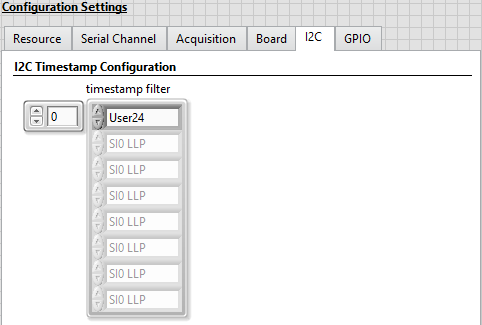
- Select the GPIO tab and make the following modifications.
- Add a GPIO line to the GPIO to Display array with the GPIO Bank value set to Des0 GPIO and the GPIO Number set to 0. Setting these values enables display of GPIO traffic for the GPIO 0 line on the SI0 channel connected to the camera.
The values on the GPIO tab of Configuration Settings are now similar to the figure below.
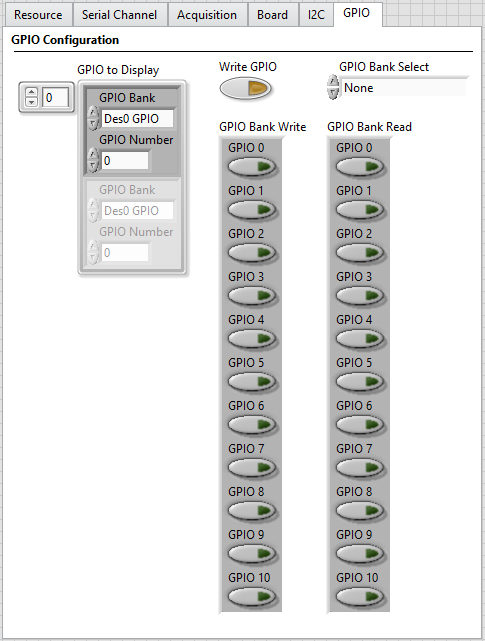
- Run the VI to setup the tap configuration and wait for the Waiting for Sensor Setup indicator to illuminate.
-
Run the Acquisition Example VI and wait for the Acquisition In Progress indicator to illuminate on the Acquisition Example VI.
-
Click the Sensor Setup Complete control button to start the tap acquisition and wait for the acquisition to complete. The default acquisition duration of 1 second is run and results are displayed on the various tabs in the Data Output indicator.
Packet Data is displayed in the First Serial Channel Packets tab.
- The Bytes Acquired (1st Channel) indicator updates as the acquisition is occurring.
- The Packets Logged (1st Channel) indicator updates after acquisition completes. See PXIe-148X Tap GSE Help for Acquired Packets (1st Channel) column details.
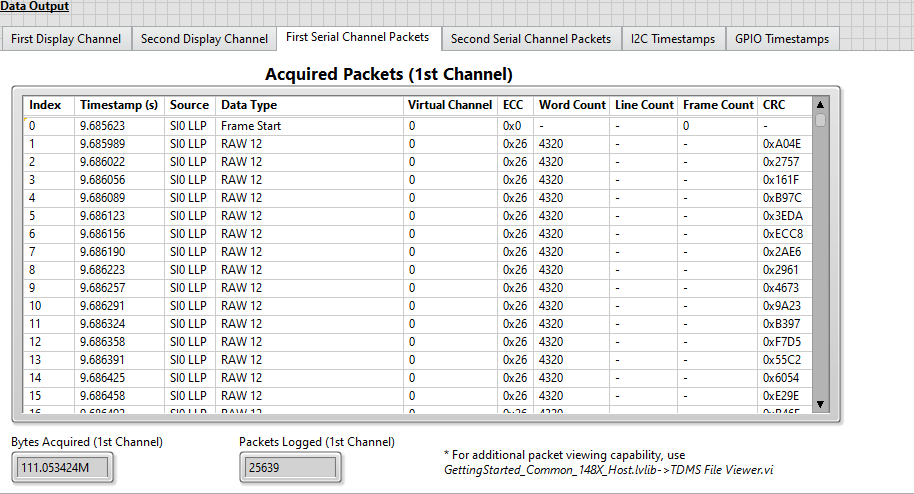
I2C timestamp data is displayed in the I2C Timestamps tab.
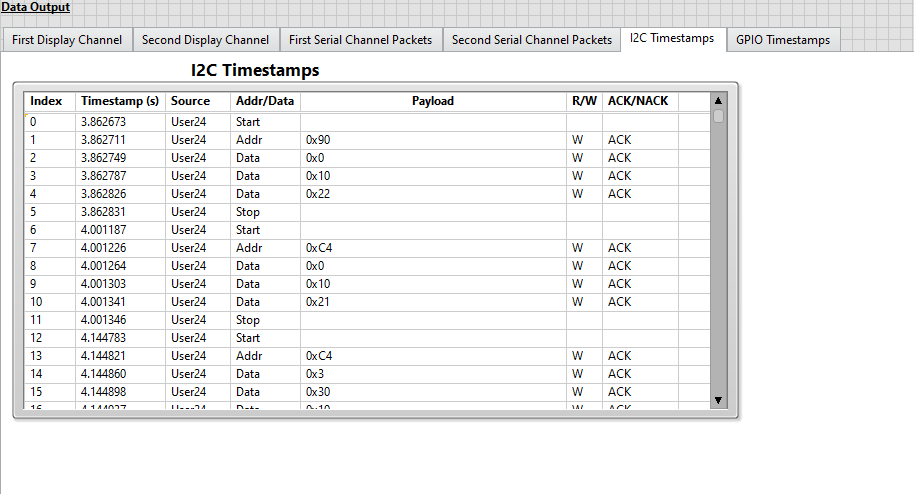
-
GPIO timestamp data is plotted in the GPIO Timestamps tab.
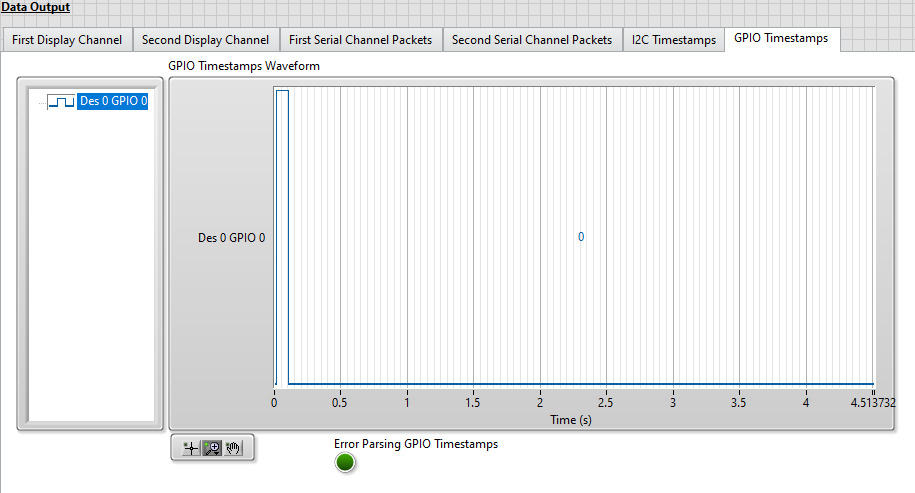
Note: The camera does not toggle GPIOs by default. The change shown in the figure above reflects GPIO level reset when the example VI is first run.
Reviewing Previously Logged Data
Note: The Reviewing Previously Logged Data tutorial assumes that the previous tutorials in this document were completed first.
TDMS files containing acquired data from the camera were saved to the "TDMS Files" subfolder in the previous tutorial. The GPIO timestamps, user timestamps, and data acquired from the camera are stored in individual TDMS files. You can use the file viewer utility to review the acquired packet data.

-
Double click the TDMS File Viewer VI in the LabVIEW project.
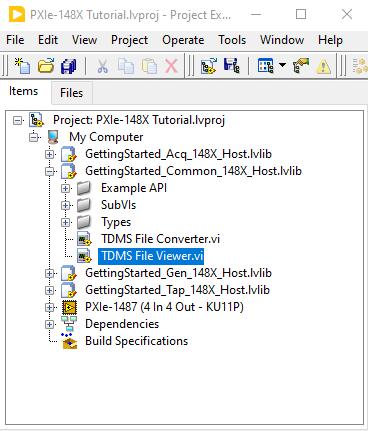
The opened front panel of the File Viewer will be similar to the figure below.
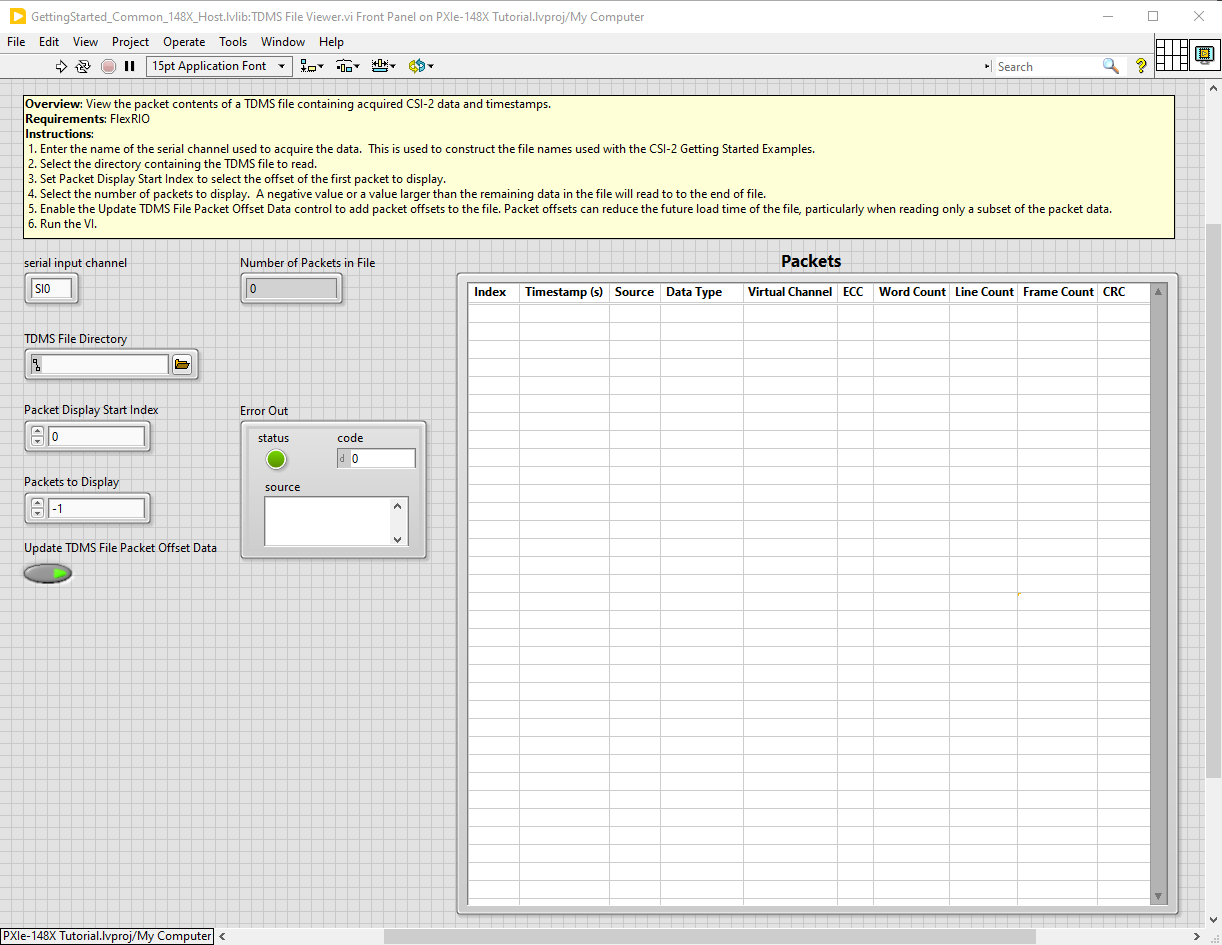
-
Select the correct location for the TDMS File Directory control. By default, TDMS files in the previous tutorial were saved to
<yourprojectdir>\Host\Tap\TDMS Files.Note: The directory browse window will not show the TDMS files located in the “TDMS Files” directory.
-
Run the VI to load the TDMS file and view the packet data.

Note: The Update TDMS File Packet Offset Data control is enabled by default. Enabling this option results in re-saving a TDMS file with additional packet indexing information the first time the TDMS file is loaded. This indexing information can reduce the future load time of the file, particularly when reading only a subset of the packet data.
-
(Optional) Update the Packet Display Start Index and Packets to Display controls to review a specific packet range of interest from the TDMS file and rerun the VI.
Using an LI-IMX490-GMSL2 camera with a vertical resolution of 1280, each frame contains a Frame Start packet followed by 1280 RAW 12 packets and a Frame End packet. To display 10 frames of data starting at the second frame, set Packet Display Start Index to 1282 and Packets to Display to 12820.
Note: Setting Packets to Display to -1 displays packets from Packet Display Start Index to the end of the file.